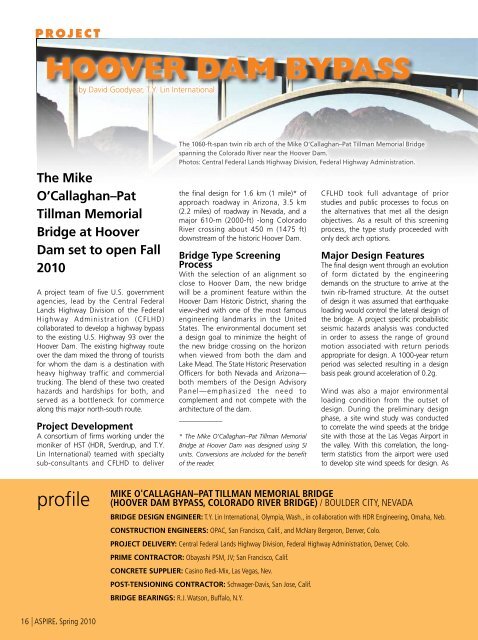ASPIRE Spring 10 - Aspire - The Concrete Bridge Magazine
ASPIRE Spring 10 - Aspire - The Concrete Bridge Magazine
ASPIRE Spring 10 - Aspire - The Concrete Bridge Magazine
Create successful ePaper yourself
Turn your PDF publications into a flip-book with our unique Google optimized e-Paper software.
P R O J E C T<br />
hoover dam bypass<br />
by David Goodyear, T.Y. Lin International<br />
<strong>The</strong> Mike<br />
O’Callaghan–Pat<br />
Tillman Memorial<br />
<strong>Bridge</strong> at Hoover<br />
Dam set to open Fall<br />
20<strong>10</strong><br />
A project team of five U.S. government<br />
agencies, lead by the Central Federal<br />
Lands Highway Division of the Federal<br />
Highway Administration (CFLHD)<br />
collaborated to develop a highway bypass<br />
to the existing U.S. Highway 93 over the<br />
Hoover Dam. <strong>The</strong> existing highway route<br />
over the dam mixed the throng of tourists<br />
for whom the dam is a destination with<br />
heavy highway traffic and commercial<br />
trucking. <strong>The</strong> blend of these two created<br />
hazards and hardships for both, and<br />
served as a bottleneck for commerce<br />
along this major north-south route.<br />
Project Development<br />
A consortium of firms working under the<br />
moniker of HST (HDR, Sverdrup, and T.Y.<br />
Lin International) teamed with specialty<br />
sub-consultants and CFLHD to deliver<br />
<strong>The</strong> <strong>10</strong>60-ft-span twin rib arch of the Mike O’Callaghan–Pat Tillman Memorial <strong>Bridge</strong><br />
spanning the Colorado River near the Hoover Dam.<br />
Photos: Central Federal Lands Highway Division, Federal Highway Administration.<br />
the final design for 1.6 km (1 mile)* of<br />
approach roadway in Arizona, 3.5 km<br />
(2.2 miles) of roadway in Nevada, and a<br />
major 6<strong>10</strong>-m (2000-ft) -long Colorado<br />
River crossing about 450 m (1475 ft)<br />
downstream of the historic Hoover Dam.<br />
<strong>Bridge</strong> Type Screening<br />
Process<br />
With the selection of an alignment so<br />
close to Hoover Dam, the new bridge<br />
will be a prominent feature within the<br />
Hoover Dam Historic District, sharing the<br />
view-shed with one of the most famous<br />
engineering landmarks in the United<br />
States. <strong>The</strong> environmental document set<br />
a design goal to minimize the height of<br />
the new bridge crossing on the horizon<br />
when viewed from both the dam and<br />
Lake Mead. <strong>The</strong> State Historic Preservation<br />
Officers for both Nevada and Arizona—<br />
both members of the Design Advisory<br />
Panel—emphasized the need to<br />
complement and not compete with the<br />
architecture of the dam.<br />
____________<br />
* <strong>The</strong> Mike O’Callaghan–Pat Tillman Memorial<br />
<strong>Bridge</strong> at Hoover Dam was designed using SI<br />
units. Conversions are included for the benefit<br />
of the reader.<br />
CFLHD took full advantage of prior<br />
studies and public processes to focus on<br />
the alternatives that met all the design<br />
objectives. As a result of this screening<br />
process, the type study proceeded with<br />
only deck arch options.<br />
Major Design Features<br />
<strong>The</strong> final design went through an evolution<br />
of form dictated by the engineering<br />
demands on the structure to arrive at the<br />
twin rib-framed structure. At the outset<br />
of design it was assumed that earthquake<br />
loading would control the lateral design of<br />
the bridge. A project specific probabilistic<br />
seismic hazards analysis was conducted<br />
in order to assess the range of ground<br />
motion associated with return periods<br />
appropriate for design. A <strong>10</strong>00-year return<br />
period was selected resulting in a design<br />
basis peak ground acceleration of 0.2g.<br />
Wind was also a major environmental<br />
loading condition from the outset of<br />
design. During the preliminary design<br />
phase, a site wind study was conducted<br />
to correlate the wind speeds at the bridge<br />
site with those at the Las Vegas Airport in<br />
the valley. With this correlation, the longterm<br />
statistics from the airport were used<br />
to develop site wind speeds for design. As<br />
profile<br />
mike o'callaghan–pat tillman memorial bridge<br />
(hoover dam bypass, colorado river bridge) / boulder city, NEVADA<br />
bridge design ENGINEER: T.Y. Lin International, Olympia, Wash., in collaboration with HDR Engineering, Omaha, Neb.<br />
construction ENGINEERs: OPAC, San Francisco, Calif., and McNary Bergeron, Denver, Colo.<br />
project delivery: Central Federal Lands Highway Division, Federal Highway Administration, Denver, Colo.<br />
PRIME CONTRACTOR: Obayashi PSM, JV; San Francisco, Calif.<br />
concrete supplier: Casino Redi-Mix, Las Vegas, Nev.<br />
POST-TENSIONING CONTRACTOR: Schwager-Davis, San Jose, Calif.<br />
bridge bearings: R.J. Watson, Buffalo, N.Y.<br />
16 | <strong>ASPIRE</strong>, <strong>Spring</strong> 20<strong>10</strong>

















